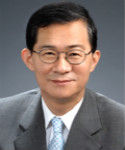
Prof. YoungPak Lee
Hanyang University, Korea/ Fudan University, China
Title: Advanced ultra-broadband perfect-absorption metamaterials, made easy
Abstract:
Recently, flexible and ultrathin wide-band MM absorbers were suggested and demonstrated in the MHz/GHz-frequency range. The experimental absorption band over 97% was 0.87-6.11 GHz. Furthermore, the dielectric substrate of MM absorbers was replaced with flexible substrate in order to have the flexibility and the broadband absorption properties. This innovation is expected to contribute to the flexible microwave/electronic devices in the near future, and offers a different approach to realize the potential wearable meta-devices by using these ultrathin broadband MM absorbers.
Absorption of electromagnetic waves in a broadband frequency range with polarization insensitivity and incidence-angle independence has been needed greatly in modern technology applications. We present a metasurface structure which was fabricated simply by employing the standard printed-circuit-board technique, but provides a high absorption above 90% in a broadband frequency range from 12.35 to 14.65 GHz. The metasurface consisted of the structural unit cells of 4 symmetric sub-structures assembled with metallic-bar pattern, which induced a broadband absorption by using a planar resistive interation in the pattern without real resistive component there. The analysis, simulation, and measurement results showed that the metasurface also turned out to be polarization-insensitive and still maintained the absorption above 90% at incident angles up to 45o.
We also suggest a plasmonic metasurface structure that was simply fabricated using the standard printed circuit board technique but provided a high absorption above 90%, also covering a broadband frequency range from 12.30 to 14.80 GHz. This plasmonic metasurface consisted of structural unit cells composed of multiple split rings connected by a copper bar. Analysis, simulation, and measurement results showed that the metasurface also showed polarization-insensitive properties and maintained an absorption above 90% at incident angles up to 45 degrees. The suggested plasmonic metasurface is a fundamental design that can also be used to design the absorber in different frequency ranges and is able to adapt well to being fabricated at various scales.
Biography:
YoungPak Lee received his B. S. degree from Seoul National University, Korea, in 1975, and the Ph. D. degree in experimental condensed-matter physics in 1987 from Iowa State University, U. S. A. His research involved study on magneto-optical, magnetic, optical and transport properties, and electronic structures of thin films and nanostructures, characterization of the surfaces and interfaces of thin films including multilayers, vacuum science, and so forth since his Ph. D. degree. After many careers in U. S. A., Japan, Germany and Korea, he is now former President of the Korean Physical Society, former President of the Korean Federation of Basic-science, Distinguished Professor, Physics Department of Hanyang University, and Director of Quantum Photonic Science Research Center, Seoul, Korea, which exploited the convergence research of magnetism and optical science. Prof. Lee is also Member of Korea Academy of Science and Technology, Council of Association of Asia-Pacific Physical Societies, Honorary Member of National Academy of Sciences of Ukraine, Distinguished Visiting Professor of Aix-Marseille Univ. (France) and Edith Cowan Univ. (Australia), Guest Distinguished Professor / Professor of 7 Chinese Universities and Institutes, Scientific Advisor of Scientific Council of Materials Science of Vietnamese Academy of Science and Technology. His current investigations include metamaterials and spin-photonic crystals, nanoscopic investigation of morphology and magnetic domain, and magnetic semiconductors based on oxides. He has published 640 SCI papers (the total published number of papers : 750 papers) as of December 2014. Because of these achievements, he has received many kinds of awards (48 awards as of December 2014), including the highest-level Award from the Korean Physical Society (2014), Award by the Korean Minister of Education, Science and Technology (2009), Award by the Korean Minister of Science and Technology (1992), and various academic-paper awards and academic-achievement awards. Based on these recognitions, he was also selected as one of the 'Korean Scientists for the 21st Century' by a main national broadcasting company in 2007. He has led the globalization of Korean physics, based on the leadership in the research on quantum photonic science. So far, he has established the global collaboration network with 42 organizations in 15 countries, including the U. S. A. and China.